We will look at 2 matches about defending Manchester City set attacks: Manchester City vs Tottenham and Manchester City vs Everton. Let’s start with Tottenham match.
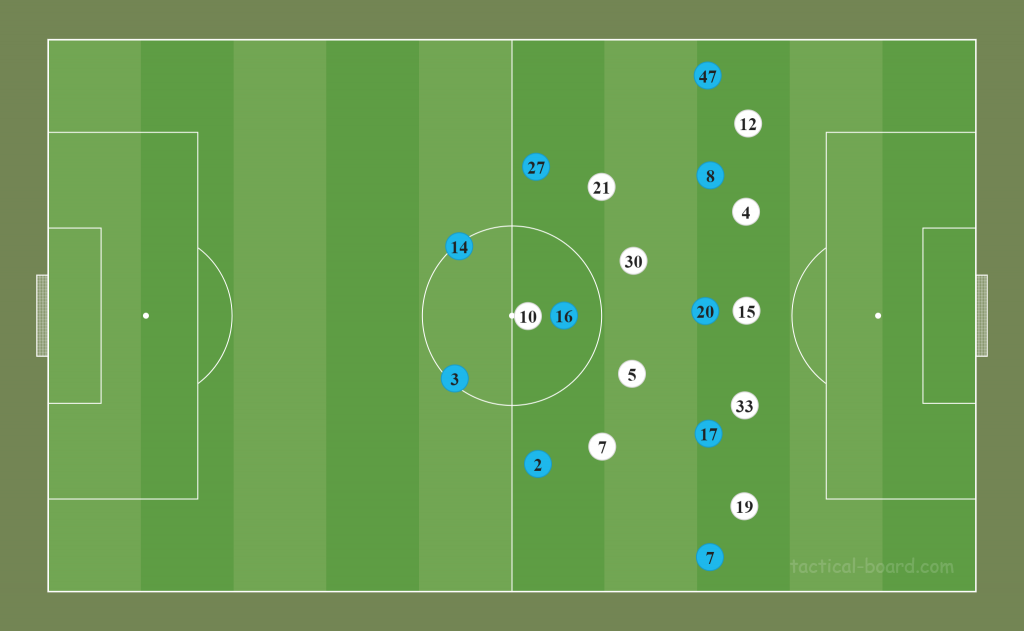
Against Tottenham, Manchester City tried to make game with 2-3-5 and Tottenham were in 5-4-1 line up in set defences.
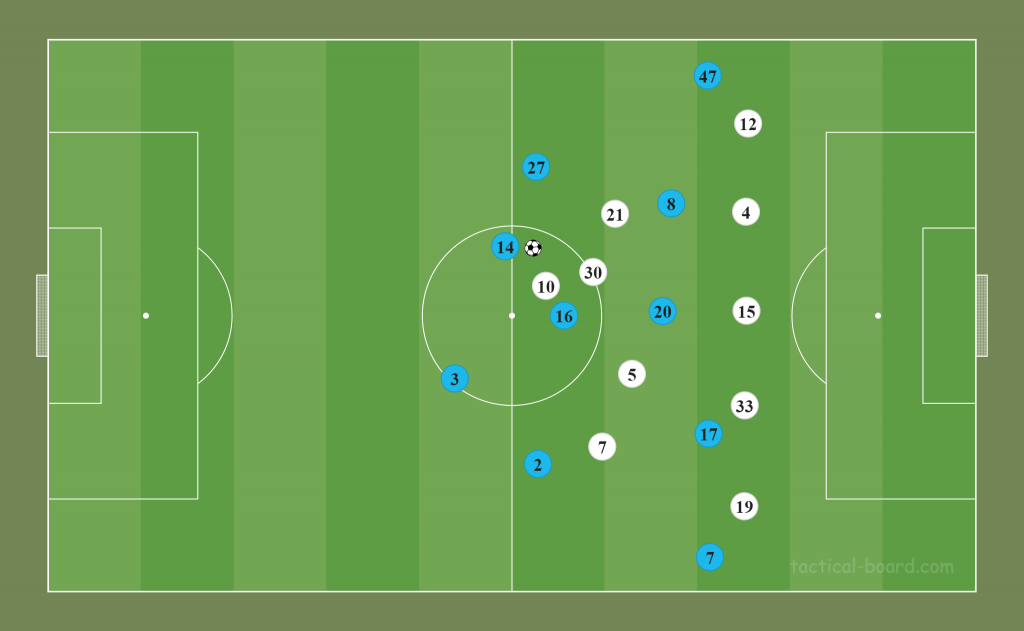
When Manchester City’s one stopper had the ball, Manchester City’s one centre midfielder and centre forward closed to midfield to take the ball. But they couldn’t take the ball. When stopper had the ball, Tottenham’s one of the centre midfielders closed to stopper. He wasn’t aggressive and stopper had time and space to make game until stopper reached midfield’s front. But also when centre midfielder closed to stopper, he cut the connection between Manchester City’s stopper and centre forward. So stopper couldn’t pass to centre forward.
Manchester City’s centre midfielder couldn’t take the ball from stopper either. Because when Tottenham’s centre midfielder closed to stopper, Tottenham’s winger cut the connection between Manchester City’s stopper and centre midfielder.
Tottenham’s centre forward covered Manchester City’s defensive midfielder with shadow marking and didn’t let him take the ball comfortably either.
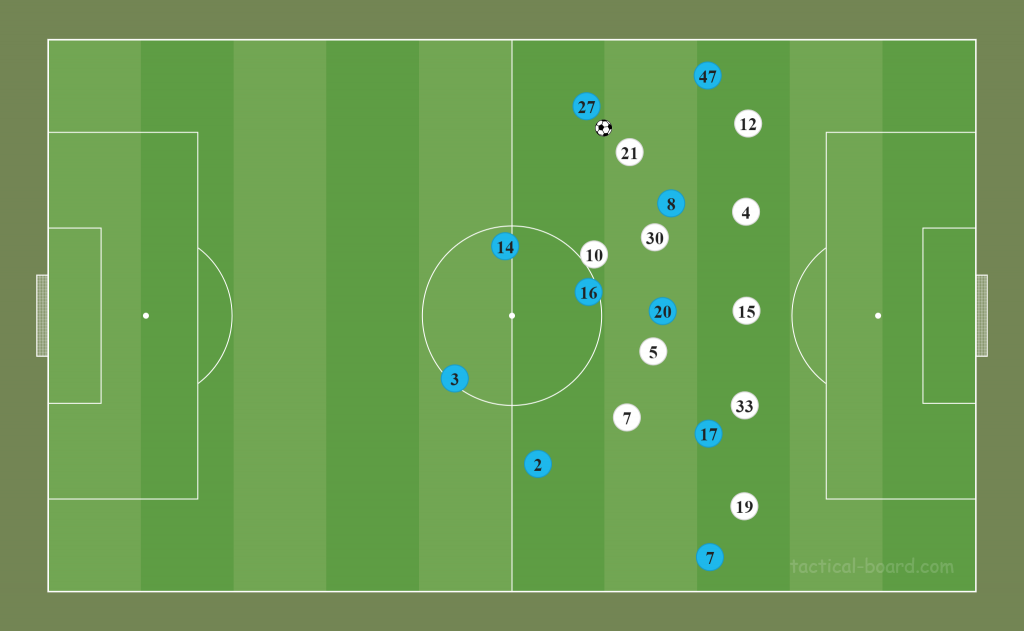
So to pass the ball forward, stopper’s only pass option was left back. But left back couldn’t be effective with the ball because when left back had the ball, Tottenham’s winger took position between Manchester City’s centre midfielder and left back. So left back couldn’t pass to centre midfielder. And Tottenham’s centre forward kept covering Manchester City’s defensive midfielder with shadow marking. Only Manchester City’s winger could take the ball so left back passed to winger.
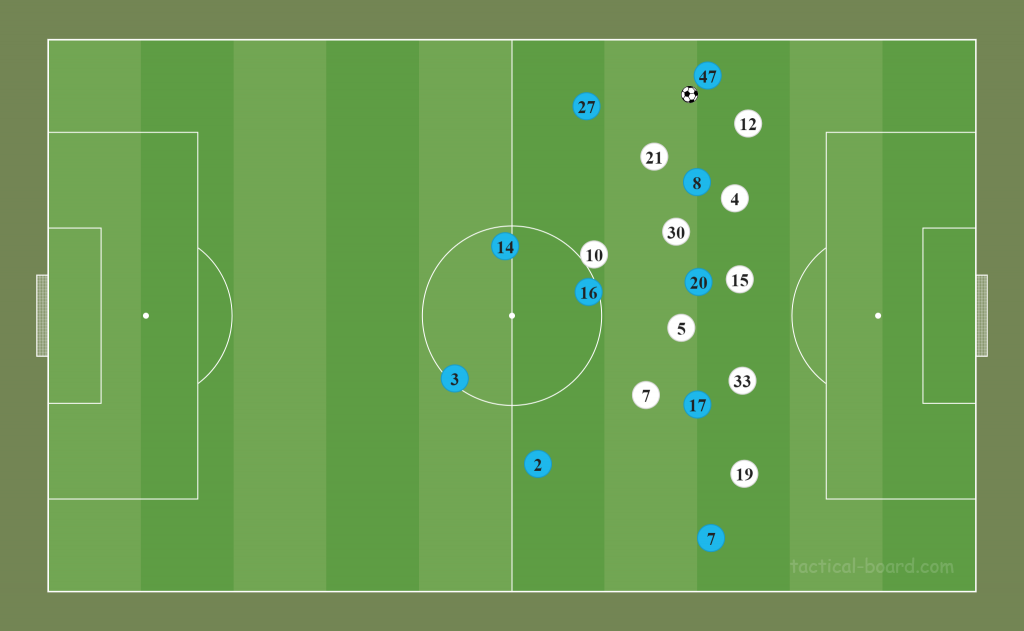
After winger took the ball, he could pass to centre midfielder. Now Tottenham’s winger couldn’t cut the connection between Manchester City’s winger and centre midfielder. When Manchester City’s left back had the ball before Manchester City’s winger, Tottenham’s winger took position closer to left back more than Manchester City’s centre midfielder. Tottenham’s winger took position closer to left back because now the ball was more closer to goalpost. When Manchester City’s stoppers had the ball, Tottenham’s midfielders or forwards didn’t have to take position closer to stoppers because stoppers were not closer to Tottenham’s goalpost like Manchester City’s full backs. So because Tottenham’s winger was taking position closer to left back, he couldn’t take position quickly between centre midfielder and winger when winger had the ball.
But Manchester City couldn’t use this advantageous situation either because this time, Tottenham’s one of the stoppers closed to the free Manchester City centre midfielder and didn’t let him take the ball comfortably. Stopper could close to centre midfielder comfortably because Tottenham’s defenders had numerical equality against Manchester City’s forward and centre midfielders with 5 vs 5. So closing to centre midfielder didn’t create a disadvantageous situation for Tottenham’s defense line.
So basically, Tottenham’s centre forward, wingers and centre midfielders tried to cut the connection between Manchester City’s defenders and midfielders. And if Manchester City’s centre midfielders found free space in half-space, Tottenham’s stoppers covered them and didn’t let them take the ball comfortably.
Then Manchester City used different things but they didn’t work. For example, sometimes right centre midfielder closed to left half-space as an extra player. But he couldn’t be effective because when he shifted to left half-space, Tottenham’s left centre midfielder and left winger shifted a little bit too. Sometimes Manchester City’s left back shifted to wing more. But he couldn’t be effective either because this time, Tottenham’s right winger shifted to wing a little bit more and covered left back.
Now let’s look at the second match. Against Everton, Manchester City had the same system in set attacks. Everton met Manchester City with 4-5-1 line up.
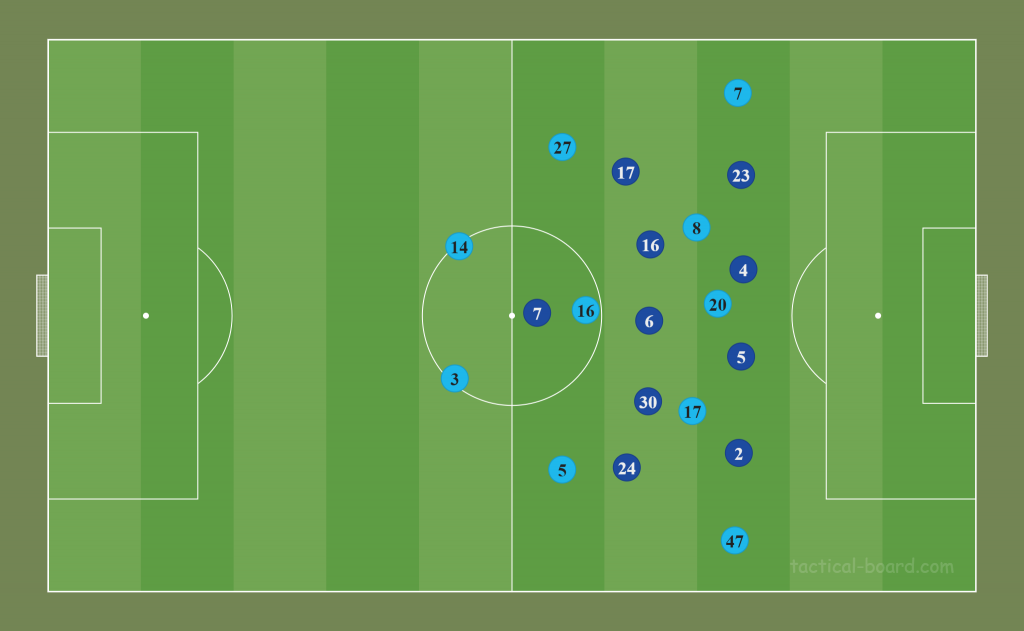
Centre forward covered Manchester City’s defensive midfielder with shadow marking like Tottenham’s centre forward. But he closed to stoppers more so Everton midfielders had to be more careful about covering Manchester City’s defensive midfielder.
In Everton’s set defence system, there were more man markings than Tottenham. Everton’s 4 midfielders directly matched with Manchester City’s 2 full backs and 2 centre midfielders. But sometimes it made a problem for Everton because if Manchester City’s one midfielder closed to a different space, for example if right centre midfielder closed to left half-space, this time because Everton’s players didn’t use zone marking, this player could be free. Against Tottenham, Manchester City’s players tried to use this to make game too but Tottenham didn’t use man marking and with little shifts, they could cover spaces effectively. I explained it before in this article.
Everton had 1 extra player in midfield. Defensive midfielder didn’t match with Manchester City’s any player directly. He closed to the space where needed help. And also when Manchester City’s centre forward closed to midfield to take the ball, he covered centre forward and didn’t let him to take the ball comfortably.
Everton had 4 defenders against Manchester City’s 3 forwards and 2 centre midfielders. So there was a numerical disadvantageous situation for Everton. It helped Manchester City to close to Everton’s penalty box because defenders were not comfortable to cover Manchester City’s attackers closely and aggressively. Especially from half-spaces, Manchester City’s players could find free space because stoppers and full backs didn’t have a particular role to cover the Manchester City player who was in half-space.
Half-space is the space that because between wing and centre, it can confuse defenders’ minds more easily. Because if defenders focus on to half-space too much, this time centre could be free but if they don’t focus on to half-space, this time attackers can be effective from half-spaces because half-space is not too far away from centre like wing.
Sometimes both stopper and full back didn’t close to centre midfielders. Stopper didn’t because centre forward could escape from his back. Full back didn’t because when Manchester City’s winger used wing to escape from defense line’s back, full back had to focus on to winger instead of centre midfielder. So sometimes Manchester City found spaces from half-spaces.
Tottenham didn’t let Manchester City find free spaces in half-spaces. Because Tottenham had 5 defenders. So right and left stoppers could match with Manchester City’s right and left centre midfielders directly. And because of that, full backs could focus on to wingers too. So they had particular roles and because of that, Manchester City’s centre midfielders couldn’t confuse Tottenham defenders’ minds.
Manchester City couldn’t be so effective against Everton because even Manchester City’s centre midfielders found space in between midfield and forward line’s half-spaces, Everton’s defensive midfielder shifted to defense line to be the extra player in defense line. So before Manchester City’s players could go forward, he shifted to defense line. And this time, like Tottenham, they met Manchester City’s 3 forwards and 2 centre midfielders with 1 by 1. They equalized numerically.
So if we make a summary from two matches, if you meet Manchester City’s defensive midfielder and two full backs closely, they can’t make game from behind comfortably. And if you don’t let Manchester City use half-spaces in closer to penalty box, Manchester City stuck. But to defend half-spaces, defending team’s players need particular and clear roles about defending half-spaces. Or players can’t decide who has to defend half-space and this time, Manchester City can find free spaces from half-spaces.

